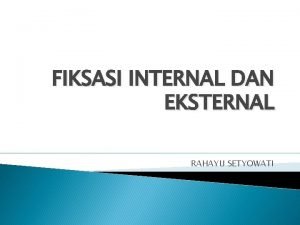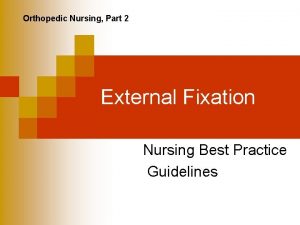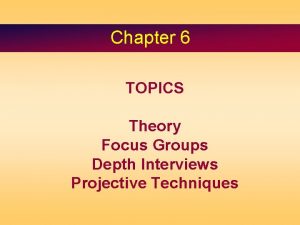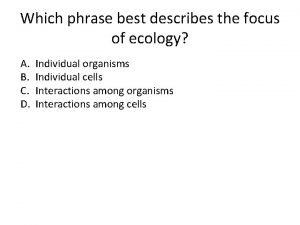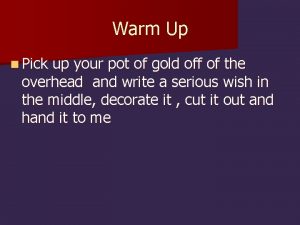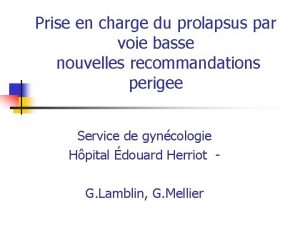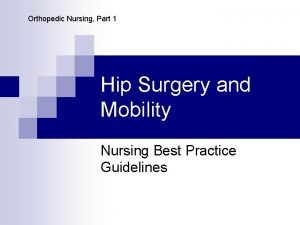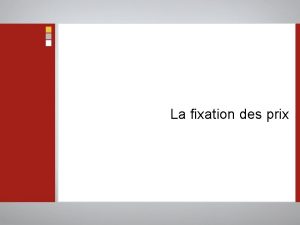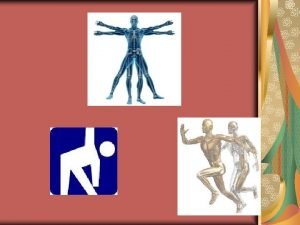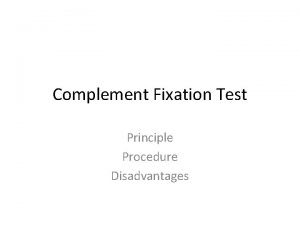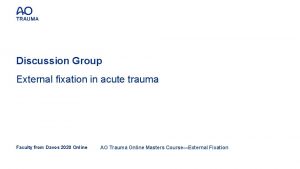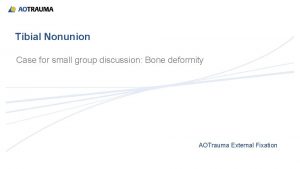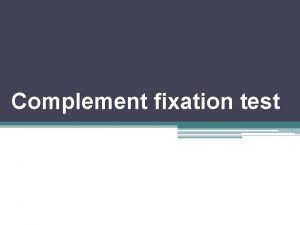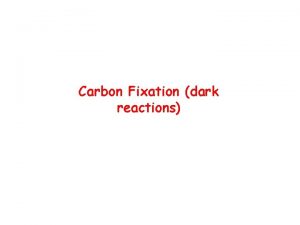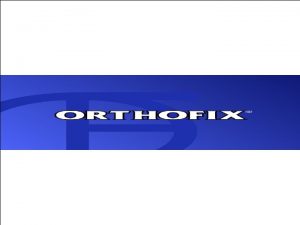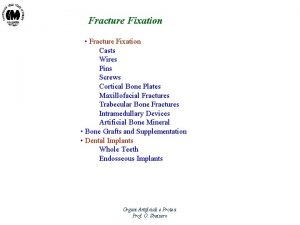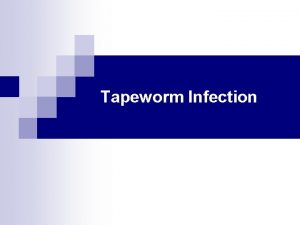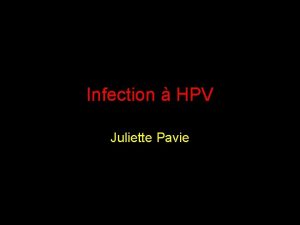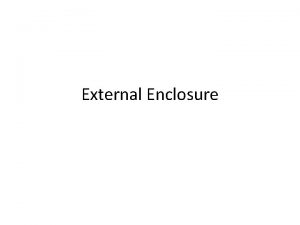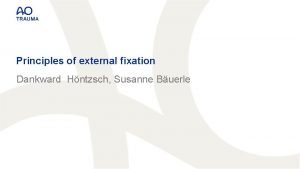Discussion group 2 External fixation in nonunion infection




























































- Slides: 60

Discussion group 2 External fixation in nonunion, infection, and treatment of bone defects AO Trauma Online Masters Course—External Fixation

Case 1: Nonunion of tibia 2

• 42 -year-old man: 12 years status post open fracture • Previous intramedullary (IM) nail • No drainage, normal knee and ankle, pain with walking • Erythrocyte sedimentation rate: 32 3

• 42 -year-old man: 12 years s/p open fracture • Previous IM nail • No drainage, normal knee and ankle, pain with walking • Erythrocyte sedimentation rate: 32 • C-reactive protein < 1 • No infection suspected 4

Options for treatment? 1. Resection of nonunion with shortening, and lengthening at a more proximal location 2. Acute correction—IM nail then distraction 3. Gradual correction and distraction/deformity correction with ring fixator (hinge) 4. Gradual correction and distraction with hexapod frame 5. Gradual deformity correction at nonunion site and then lengthening at a proximal site 5

• Hexapod frame placed • Fibular osteotomy • Slow correction through nonunion (0. 25 mm/day) 6

Options? • Deformity corrected with difficulty and pain • Still 3 cm short 7

Options? 8 1. Continue distraction at 0. 25 mm/day? 2. Add proximal ring and continue lengthening via a new corticotomy (proximal)

Options? 9

10 • Proximal ring added—new corticotomy • 3 cm additional length obtained

11 • Proximal ring added—new corticotomy • 3 cm additional length obtained

Take-home messages • Hypertrophic nonunion can be distracted to correct deformity and create new bone • Consider separate location for lengthening if amount of bone is significant or difficulties arise 12

Case 2: Tibial defect 13

• • • Defect 10 cm Shortening 2 cm Varus Knee ROM 80/0/0 Ankle ROM 10/0/0 What next? 14

Preoperative planning 15

Preoperative planning • 2 -level corticotomy Corticotomy

Preoperative planning • 2 -level corticotomy Ring positions • Device: ring external fixator Corticotomy Ring positions

Preoperative planning • 2 levels corticotomy Ring positions • Device: ring external fixator • Method: 2 -level bone transportation (trifocal) Corticotomy Ring positions

Step 1: bone transport 19

Step 1: bone transport 20

Step 1: bone transport 21

Step 1: bone transport 22

Step 1: bone transport Next step? 23

Step 1: bone transport Next step? • 24 How to manage the docking site and deformity

Step 1: bone transport Next step? • 25 Fragments stabilization? How to manage the docking site and deformity

Step 1: bone transport Next step? • 26 Fragments stabilization? How to manage the docking site • Continue with ring? • Converse to nail? and deformity • Converse to plate?

Step 2: docking-site procedure with grafting Stable fixation for 5 months 27

Treatment period 8 months 28

Treatment period 8 months 4 years follow up 29

Take-home messages • In case of bone defects, malunion, deformities, and shortening—different types of surgical decisions are available • Ring fixator can correct bone defect; shortening malunion and deformities in one system • Multilevel corticotomy can be used for long bone defect • Bone graft at docking site is really useful to achieve union 30

Case 3: Distal tibial injury with infection 31

• • 48 -year-old man Industrial fall Open pilon Transferred 2 weeks after injury: wound still open • Serratia infection • Infected articular fragments in the wound • What are your thoughts? 32

• • 48 -year-old man Industrial fall Open pilon Transferred 2 weeks after injury: wound still open • Serratia infection • Infected articular fragments in the wound • What are your thoughts? 33

a. Antibiotic spacer and flap— plan for a Masquelet technique/ankle fusion using a hindfoot fusion nail b. Acute shortening to an ankle fusion—no need for softtissue coverage—proximal tibial lengthening c. Flap coverage and bifocal transport to an ankle fusion with a proximal corticotomy d. Other? 34

a. Antibiotic spacer and flap— plan for a Masquelet technique/ankle fusion using a hindfoot fusion nail b. Acute shortening to an ankle fusion—no need for softtissue coverage—proximal tibial lengthening c. Flap coverage and bifocal transport to an ankle fusion with a proximal corticotomy d. Other? 35

36

37

38

3. 5 cm 39

3. 5 cm • Final debridement in preparation for transport to ankle fusion 40

3. 5 cm • Final debridement in preparation for transport to ankle fusion • Rectus abdominus free flap 41

3. 5 cm • Final debridement in preparation for transport to ankle fusion • Rectus abdominus free flap • Ilizarov frame placed 3 days later 42

43

0. 75 mm/day transport rate 44

How should we manage the docking at the site of the ankle fusion? 0. 75 mm/day transport rate 45

• Rectus free flap was elevated • Iliac crest bone graft to docking site • Distal part of frame converted to hexapod to fine-tune position of the ankle fusion 46

• Rectus free flap was elevated • Iliac crest bone graft to docking site • Distal part of frame converted to hexapod to fine-tune position of the ankle fusion 47

• Rectus free flap was elevated • Iliac crest bone graft to docking site • Distal part of frame converted to hexapod to fine-tune position of the ankle fusion 48

Ankle fusion position verified on AP/lateral and a “heel view” 49


At 1 year 51

Take-home messages • When the joint is destroyed by trauma and infection, fusion is often a good option • Coverage with flap optimal to help clear infection • Bifocal treatment useful to maintain leg length • Fusion can be difficult, preparation of the docking site ± bone graft should be considered • Hexapod useful to allow optimal fusion position 52

Case 4: Pin tract infection and frame instability 53

• • 54 52 -year-old man Deep infection 17 cm tibia defect Frame for spacer stabilization after debridement

Frame examination shows signs of pin-tract infection • What are the causes? • How to prevent? • How to treat? 55

Frame examination: signs of instability • What are the causes? • How to prevent? • How to treat? 56

Frame examination: signs of instability • Frame removal? (next step? ) • Frame reassembling (why? how? ) • Other choices? 57

• Frame reassembling • Replacement of unstable wires • Wires tensioning 58

• Frame reassembling • Stabilizing half-pins insertion 59

Take-home messages • One of the causes of wire sites infection is unstable frame • Unstable frame will be infected frame soon (100%) • Needed level of stability depends on the purpose of using the frame (damage control orthopedics ≠ reconstructive surgery, needs more stability) • Proper level of stability must be provided with minimal number of wires, pins, and rings 60
 Indication of external fixation
Indication of external fixation External fixation device nursing care
External fixation device nursing care Roman hayda md
Roman hayda md Discussion discussion
Discussion discussion External-external trips
External-external trips What is a gd
What is a gd Buzz group technique
Buzz group technique Effective group discussion
Effective group discussion Prerequisites of a group discussion
Prerequisites of a group discussion Objective of group discussion
Objective of group discussion Group discussion images
Group discussion images Panel discussion meaning in tamil
Panel discussion meaning in tamil Advantages of focus groups
Advantages of focus groups How to start a group discussion
How to start a group discussion What is buzz group
What is buzz group Group discussion images
Group discussion images Group discussion assessment criteria
Group discussion assessment criteria Group discussion on food
Group discussion on food Smart work vs hard work group discussion
Smart work vs hard work group discussion Group discussion parameters
Group discussion parameters Dos and don'ts of group discussion
Dos and don'ts of group discussion Group discussion
Group discussion 10302020
10302020 Focus group discussion example
Focus group discussion example Group discussion dialogue writing
Group discussion dialogue writing Dr abhishek chowdhury
Dr abhishek chowdhury Effective group discussion: theory and practice
Effective group discussion: theory and practice Which phrase best describes a consumer in an ecosystem?
Which phrase best describes a consumer in an ecosystem? Oral fixation examples
Oral fixation examples Psychoanalytic theory
Psychoanalytic theory Psychosexual fixation
Psychosexual fixation Suspension therapy is a type of
Suspension therapy is a type of Projective test example
Projective test example Fixation of anal stage
Fixation of anal stage Latency stage
Latency stage Anal fixation
Anal fixation Nerf
Nerf Examples of defense mechanisms
Examples of defense mechanisms Sigmund freud psychoanalysis theory
Sigmund freud psychoanalysis theory Phallic stage
Phallic stage Undoing defense mechanism examples
Undoing defense mechanism examples Sublimation psychology
Sublimation psychology How should a fracture pan be positioned
How should a fracture pan be positioned The electra complex
The electra complex Les étapes de fixation des prix
Les étapes de fixation des prix Fixation in kinesiology
Fixation in kinesiology Psychosexual fixation
Psychosexual fixation Anal stage fixation
Anal stage fixation 5 psychosexual stages
5 psychosexual stages Thelibidolife.com
Thelibidolife.com Fixation defense mechanism
Fixation defense mechanism Fixation of anal stage
Fixation of anal stage Aim of tissue processing
Aim of tissue processing Procedure of tissue processing
Procedure of tissue processing Alberts
Alberts Primary and supporting instruments
Primary and supporting instruments Phallic stage
Phallic stage Energy fixation
Energy fixation Nitrogen fixation is the conversion of
Nitrogen fixation is the conversion of Instrument cross check
Instrument cross check Advantages and disadvantages of 2's complement
Advantages and disadvantages of 2's complement
